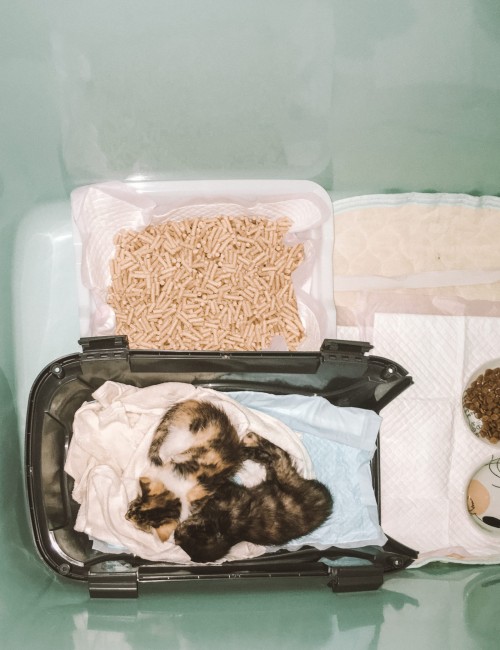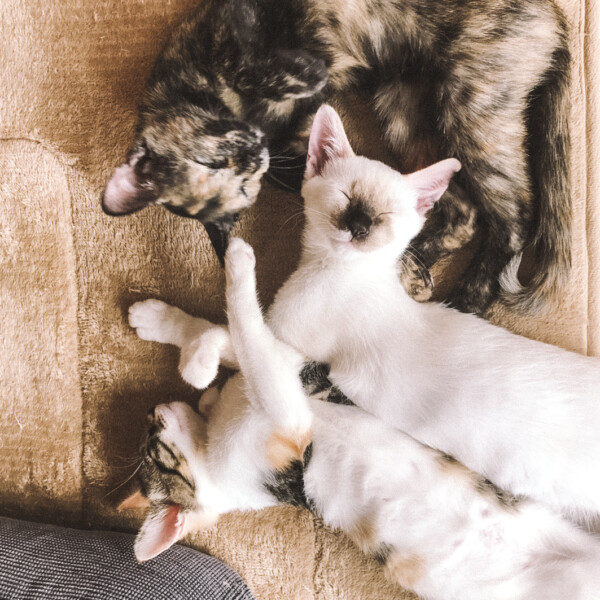When it comes to training and preventing cat behaviour issues, its best to not allow problems to continue and develop into a habit. Instead, it is important to identify problematic behaviours and causes, and try to prevent them. Cats are capable of learning which behaviours are acceptable and unacceptable, and with patience, can be taught so by you.
Punishment vs Positive Reinforcement
What’s most important in preventing problem behaviours from continuing in new cats is avoiding punishment. Please remember that the behaviour isn’t being done out of spite but as a response to a stressful and new situation. Since common problems include aggression and litter box issues, punishing your cat will further heighten their stress and possibly lead to more problems. Your pet is scared and looking to you for direction and for the best outcome, this direction needs to be provided in a loving and calm manner. When it comes to cat’s behaviour issues, the 3 Rs which cats respond best to are: redirection, rewards, and repetition.
Health vs Heat Related Issues
All of the following behaviour problems can occur due to a health issue. If behaviours come on suddenly or seem related to pain and discomfort, immediately consult with a vet to identify the health issue. All newly adopted or rescued cats should be taken to the vet for an initial checkup to clear them of any common health problems. Please read this post to learn more about the most common health issues that cats can have.
Many of the following behaviour problems can also be a result of a cat being in heat. Common heat related issues can include unstoppable nighttime yowling, spraying, and sudden aggression. Please read this post for detailed information on the types of behaviours which can be prevented by spaying or neutering your cat as soon as it is safe to do so.
1. Hyperactivity & Vocalization
Hyperactivity at Nighttime: Since cats are nocturnal animals, loud and energetic play at night is very common. There are several ways to reduce this or prevent it altogether. Outdoor cats hunt throughout the day for their food and this results in almost constant activity. This aspect of a cat’s life differs drastically in indoor cats. Often, cats are left alone for the majority of the day and they spend this time snoozing and building up energy. Consult this post, to learn how to enrich your home. This will allow your cat to be active during the day and use up excess energy.
Prevention: Furthermore, since nighttime activity is actually their hunting instinct kicking in, you can satisfy this need right before bedtime. Spending 15 to 20 minutes engaged in energetic play with your cat is a really good way to tire them out before bed. It is best to end this play with slowing things down and giving them a treat to signal the end of the “hunt”. You will also find that as cats age, these bursts of energy at night begin to reduce and may even disappear.
Vocalization for Needs & Boredom: Vocalizing throughout the day is normal and your cat’s way of commuting their needs. While responding with pets or treats may temporarily stop the vocalization, your actions will encourage them to continue the behaviour during the day and night. Instead, it is best to ignore the sounds and even invest in some good earplugs for the time being. In time, your cat will accept your lack of response and the vocalizations should diminish.
Prevention: The best way to prevent night vocalization is to provide them with lots of play before sleep to tire them out. Furthermore, before going to sleep, make sure the cat has enough food, water, and a clean litter box. You can also leave out some toys at night in a different room for them to play with. With the major needs provided for, in addition to nighttime play before bed, your cat’s sleep schedule will eventually align with yours. Doing the above can also prevent some early morning wake up calls.

2. Litter Box Issues

Due to Stress: If a previously trained cat suddenly displays litter box issues in a new home, and health issues can be ruled out, it can be due to stress. Prevention: Choose a good spot for the litter box that is easily accessible, private, and a distance away from their food. Since cats should be starting off in a small room in the house, at least accidents will be limited to this space as the cat acclimates to the changes. It is important to thoroughly clean any accidents and possibly block off locations of accidents to prevent repeats. You can also place your cat on the litter box after meals to remind them where to go and reward them with treats for appropriate use. Being in a new environment with new people is difficult for the cat and it’s important to be patient and understanding about accidents.
Due to Cleanliness: Cats are very picky about cleanliness and if the litter box is not up to their standards, they may have an “accident” out of the box. Prevention: Litter boxes should be cleaned after every use. Furthermore, they need to be deep cleaned (washed with soap and water and refilled with brand new litter) every few weeks.
Due to Size, Availability of Box & Litter Type: As your cat gets older, the litter box may need to be changed to accommodate them. It’s best if the cat can comfortably sit in the box with all four legs inside, with some space to spare. Furthermore, accidents may be happening because the box isn’t available or has been recently used by another cat. Prevention: If you think issues are related to this, invest in some additional boxes. The rule of thumb is usually one box per cat per floor. Another change that may be necessary is the type of litter. As cats age, they may become sensitive to litter that has a certain kind of smell. Try out different litters to see which one your cat prefers.
3. Biting & Scratching
Biting & Scratching Walls/Furniture: Scratching at walls or furniture is due to your cat’s natural instinct to mark its territory. Prevention: You can redirect this behaviour to scratching posts by sprinkling some catnip on it and placing the post in front of the walls or furniture being scratched. Be careful with spraying walls and furniture with chemicals or deterrents, especially if they are homemade. Anything with essential oil or citrus based is poisonous for cats so always do your research.
Biting & Scratching Other Pets: Often, what appears like aggression to you, is not real aggression, especially in younger cats. They are still learning limits and social behaviours at this age. Play fighting should only be a concern if a cat is significantly stronger than their playmate and can easily overwhelm them. Prevention: If play does ever become aggressive, signalled by a playmate crying in pain, don’t separate fighting pets by hand. Instead, a quick spray of water or a loud noise should break it up.
Biting & Scratching People: While it may be cute to allow a young kitten to bite or claw at you during play, this is not a good idea. Allowing and encouraging young kittens to claw and bite at fingers and toes will teach them that you are just another one of their playmates and that they can bite and scratch you as hard as they scratch each other. The habit will carry over into adulthood when their teeth and claws can do much more damage.
Prevention: It’s best to redirect this behaviour early on in life. Provide your cats with toys and encourage them to use these by rewarding them with treats when they do so. If they have a tendency to bite and scratch at your, always redirect this behaviour to their toys. When it comes to training cats, repetition and reinforcement are key.

4. Aggression

Due to Stress: Cats are creatures of habit and do not handle changes well. Sudden aggression may be due to changes in the routine or the home, causing the cat stress.
Prevention: It’s best to identify the trigger first and remove it if possible. If the cause of aggression is something permanent, you can help your cat get accustomed to it. You can do this at first by providing some barriers between the cat and cause of aggression, until they acclimate. Additionally, you can use favourite toys or food to create a positive association when they are around the cause of aggression.
Due to Trauma: In the case of rescue cats, they may have had a hard life on the streets or may have been abused by a previous owner. In these situations, it may take a lot of time to build trust.
Prevention: Sometimes, the best solution is to just let your cat be and allow them to acclimate at their own pace. This can be further helped along by maintaining a routine to help destress your cat. Make sure all of their basic needs are provided for and allow them to interact with you slowly. Lot’s of positive reinforcement during interactions, and patience, are key.
5. Jumping On "off limit" Surfaces
Exploring a New Space: Cats love to explore and as part of acclimating to their new space, they will want to explore every nook and cranny in your household. Part of this will include them getting on surfaces that are off limits to them such as stove tops or kitchen counter tops. These types of dangerous surfaces and similar surfaces should be off limits for your cat.
Prevention: It is a good idea to enrich the home with an alternative surface for them to jump on, in the form of perches or towers. These should be placed strategically in areas where cats like to perch on off limit surfaces. Again, redirecting and rewarding cats with treats for using perches and towers may be necessary in the beginning.
While you can try hacks such as double sided tape or aluminium foil to make off limit surfaces unappealing, it may not be enough to deter a curious cat. It’s important to restrict access to off limit spaces early on and consistently. It may require consistent and constant physical deterrence, such as removing them from the surface every time they jump up, to stop the behaviour. Sometimes, if the cat feels otherwise safe and comfortable with you, a quick spray of water may do the trick.

When I was in high school, I was told that my generation would be the generation that pursues multiple career paths and does at least three different jobs throughout their lifetime. I’d initially laughed at that thought but ten years later, here I am as a full time teacher, part time traveller, and constant animal rescuer. Also, they failed to tell me that two out of the three jobs wouldn’t even pay me.







